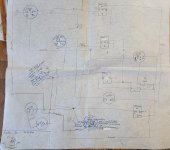New here, been active over on another site for a while. Got an interesting issue and was encouraged to try my efforts over here as well. I am always open to ideas, especially electrical ones. Cause I am not great at it.
Here is the initial deal:
This mower was bought in 2015 and has under 300 hours today, so it is not used a lot. So far this season when I have used the mower, it has performed as expected. Then it developed this issue where I could be operating the mower and it would shut down, like you turned the switch off. I can restart the mower, it will run perfect. It does not have anything hindering restarting the mower after it dies. Release the parking brake-dies. Engage the PTO with the parking brake on, while engine running in park/neutral-dies. In these two conditions the mower should continue to run without turning off.
I am looking for suggestions cause I am running out of ideas. I have replaced the following really cause I was just trying to see if it changed the scenario. So far, none of these changes have resolved this situation:
4 automotive like CIT Relay A2F1CSQ relays-replaced.
all blade fuses tested, slow blow 30amp tested for insanity purposes
Ignition switch-replaced
PTO switch-replaced
Kubota time delay switch-replaced (NOT CHEAP) (delays safety deactivation of engine due to operator bouncing in the seat etc)
seat safety switch-replaced
Parking brake switch-replaced
I have something somehow tied to the PTO and the parking brake that is stopping this machine from operating. I am down to tracing wires unless someone has an idea.
Today: mower will start and run perfect. You cannot move the machine or operate it in any other manner than this. Start it, remove parking brake-dies. Restart it, leave the brake on while sitting in the seat, sticks in neutral... engage PTO, the machine will die. (should run with blades going while sitting in neutral park.)
I will reply to this with what I have done since this initial finding.
Here is the initial deal:
This mower was bought in 2015 and has under 300 hours today, so it is not used a lot. So far this season when I have used the mower, it has performed as expected. Then it developed this issue where I could be operating the mower and it would shut down, like you turned the switch off. I can restart the mower, it will run perfect. It does not have anything hindering restarting the mower after it dies. Release the parking brake-dies. Engage the PTO with the parking brake on, while engine running in park/neutral-dies. In these two conditions the mower should continue to run without turning off.
I am looking for suggestions cause I am running out of ideas. I have replaced the following really cause I was just trying to see if it changed the scenario. So far, none of these changes have resolved this situation:
4 automotive like CIT Relay A2F1CSQ relays-replaced.
all blade fuses tested, slow blow 30amp tested for insanity purposes
Ignition switch-replaced
PTO switch-replaced
Kubota time delay switch-replaced (NOT CHEAP) (delays safety deactivation of engine due to operator bouncing in the seat etc)
seat safety switch-replaced
Parking brake switch-replaced
I have something somehow tied to the PTO and the parking brake that is stopping this machine from operating. I am down to tracing wires unless someone has an idea.
Today: mower will start and run perfect. You cannot move the machine or operate it in any other manner than this. Start it, remove parking brake-dies. Restart it, leave the brake on while sitting in the seat, sticks in neutral... engage PTO, the machine will die. (should run with blades going while sitting in neutral park.)
I will reply to this with what I have done since this initial finding.

